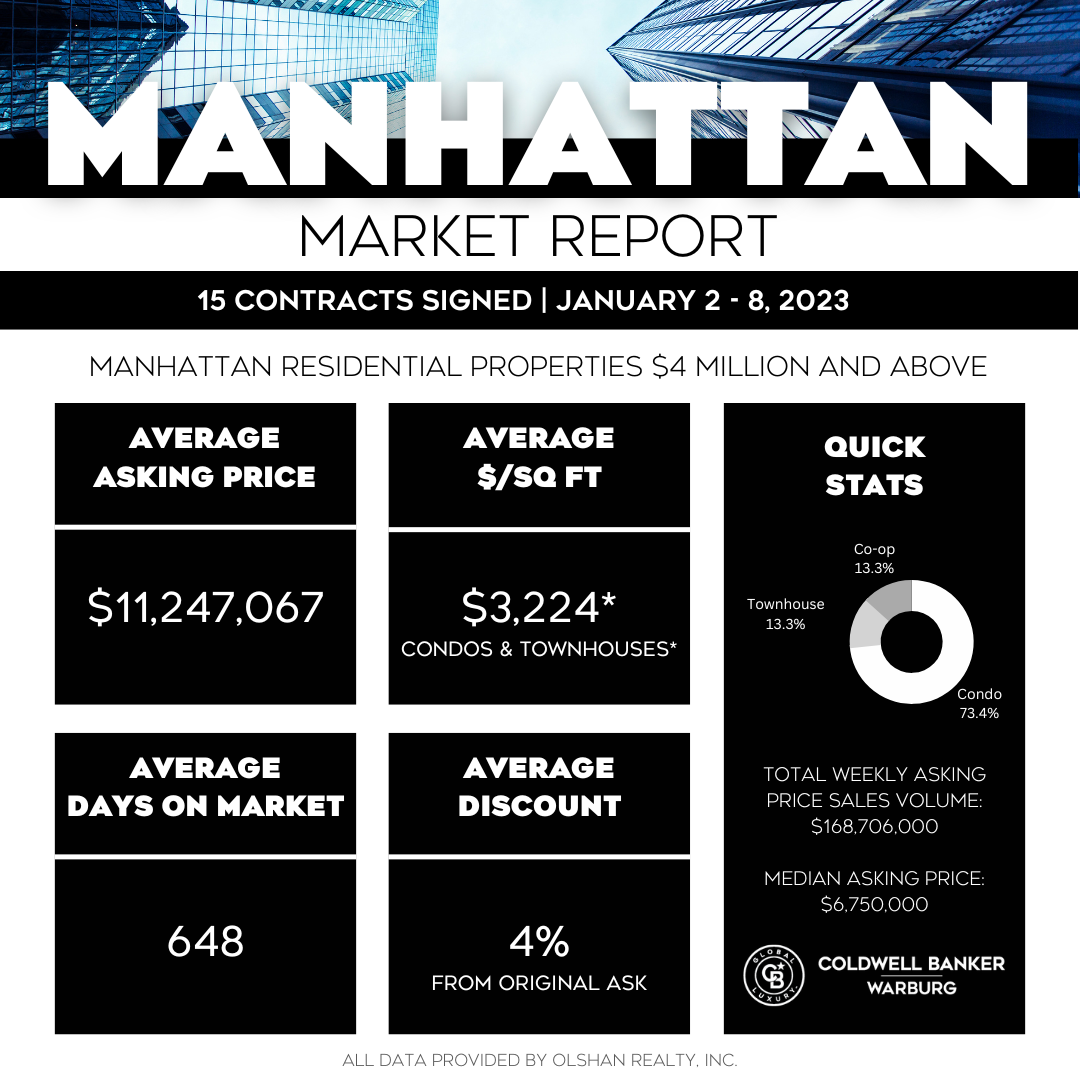Welcome to the new year, where possibilities abound. The Manhattan Market Report for the week ending January 6th, Supply closes at 5,751. Supply is ending where it began at the beginning of the year. Pending Sales at 2,401 are also down, and off-market listings (delisting) maintain the market pulse at a .40% level. Manhattan is holding on to price action due to the resilient rental market.
Per Jonathan Miller, he states “Let’s agree to refer to 2023 as the year of disappointment” because:
- Sellers will be disappointed by not selling for what they would have received in 2021.
- Buyers will be disappointed by not seeing significant discounts on housing prices.
Co-ops & Condos
“The market metric to focus on in 2022 was the surprising restraint of new supply coming into the market.”
- Median sales price slipped year over year for the first time since the pandemic era began but was well above pre-pandemic levels.
- The rate of annual sales growth went negative for the second straight quarter.
- Listing inventory slipped quarterly but was on par with pre-pandemic levels despite the sales slowdown.
- Coop’s median sales price increased year over year for the seventh consecutive quarter.
- Condo sales fell sharply year over year but remained above pre-pandemic levels.
- All luxury price trend indicators expanded annually for the fifth straight quarter.
- Luxury listing inventory expanded annually for the second quarter but was sharply below pre-pandemic levels.
- The average price per square foot of new development sales edged higher year over year but was sharply below pre-pandemic levels.
- New development sales declined sharply from the year-ago surge but remained significantly higher than pre-pandemic levels.
Freddie Mac Rates
Freddie Mac, on January 5th, released the results of its Primary Mortgage Market Survey® (PMMS®), showing the 30-year fixed-rate mortgage (FRM) averaged 6.48 percent.
“Mortgage application activity sunk to a quarter-century low this week as high mortgage rates continue to weaken the housing market,” said Sam Khater, Freddie Mac’s Chief Economist. “While mortgage market activity has significantly shrunk over the last year, inflationary pressures are easing and should lead to lower mortgage rates in 2023.”
Khater continued, “Homebuyers are waiting for rates to decrease more significantly. When they do, a strong job market and a large demographic tailwind of Millennial renters will support the purchase market. Moreover, if rates continue to decline, borrowers who purchased in the last year will have opportunities to refinance into lower rates.”
News Facts
- The 30-year fixed-rate mortgage averaged 6.48 percent as of January 5, 2023, up from last week when it averaged 6.42 percent. A year ago at this time, the 30-year FRM averaged 3.22 percent.
- The 15-year fixed-rate mortgage averaged 5.73 percent, up from last week when it averaged 5.68 percent. A year ago at this time, the 15-year FRM averaged 2.43 percent.
Luxury Market
| “Putting the expected holiday slowdown aside, the first week of 2023 picked up right where Q4-2022 left off. Demand is trending lower than the pre-pandemic 2015-2019 benchmark we introduced in our 2022 NYC New Dev Market Report, but price metrics are stable.”
– Kael Goodman, co-founder, and CEO |
The Olshan Report 15 signed contracts for listings asking over $4 million from January 2 through January 8, 2023. There were 11 condos, two coops, and two townhouses. Eight of the 13 apartments sold were in new developments, including three units at Central Park Tower, where Extell is currently offering a 5% commission to buyers’ agents.
Total Weekly Asking Price Sales Volume: $168,706,000 | Average Asking Price: $11,247,067 | Median Asking Price: $6,750,000 | Average Discount from Original Ask to Last Asking Price: 4% | Average DOM 648

Converting Unused Manhattan Commercial Office Space To Residential Apartments Is Daunting And Oversold As A Concept
Last week, there was a terrific New York Times piece on the challenges of converting unused office space to residential. According to Moodys, only 3% of the city’s office space is suitable for residential conversion.
Throw in zoning changes, the cost of conforming to residential occupancy, and negotiating with the lender who has the office as collateral on a mortgage. If possible, you’ve got five years before this could happen in scale. And with the undecided direction of remote work, who knows what the demand will be in five years?
As a follow-up to Moodys report and Times article. “Realogic Analytics” wrote some excellent pieces on the topic authored by Terry Banike. “Some offices lend themselves well to conversion; others do not. In many office buildings, large floor plates are not ideal candidates for conversion. Furthermore, the size and shape of the floor plates, on average, floor plates in multi-family buildings run 65-70 feet deep. At the same time, the average floor plate of office buildings measures 120 feet deep. If a building’s floor plate is too deep, the apartments created will be awkwardly sized or shaped. Additionally, it won’t have many windows or natural light.
This brings us to the second deciding factor—proximity to natural light. So, if a building doesn’t have many outside windows or the size and shape of its floor plates would make it difficult or impossible to create apartments with ample natural lighting. It’s probably not a good candidate for conversion. One option is to create a light well down the building’s center, but that’s expensive and, in many cases, may not be structurally feasible.
Size and shape of the inner core: most office buildings have an inner core, usually down the center, for mechanicals, like elevators, electrical, and plumbing. If the core is too expansive, or the corridors created around the core would be too big, there will be a lot of wasted space in the building, and/or the size and layout of the apartments will be awkward. Closely related is the building’s lease span, the distance from the facade to the elevators. The larger the lease span, the harder to convert.
Landmark status: some older office buildings have been granted landmark status, in which case there are strict rules about how the building can and can’t be changed that can have a significant impact on design, construction, costs, and upkeep.
Age and condition of the building: It’s not uncommon for older office buildings to have hidden problems, like mold, asbestos, lead paint and damaged concrete, or structural problems. All can drive up the cost and amount of time needed for the conversion. This is why a thorough physical inspection of the building before committing to a conversion is a must.”
These points are outlined in Realogic’s article: “An in-depth look at multi-family conversions: part 2” in the link below.
Luxury home buyers head back to the city as they adapt to new normal: SOLRE 2023



